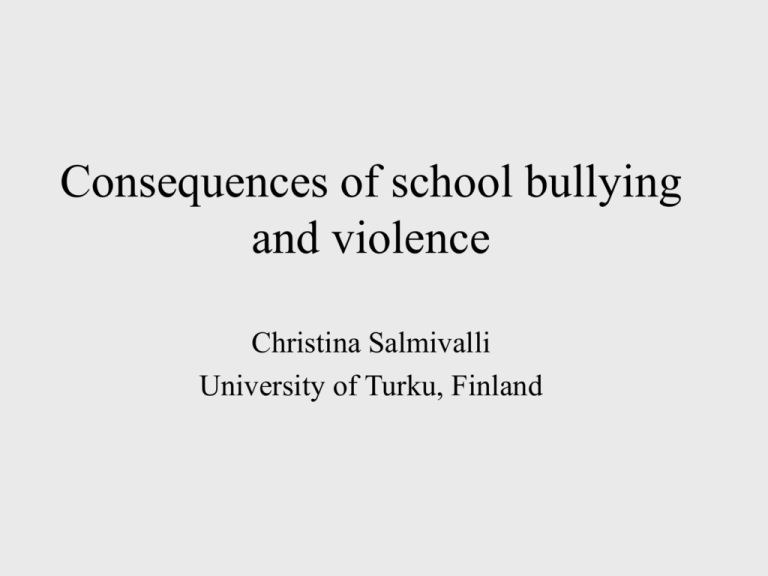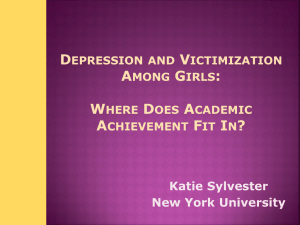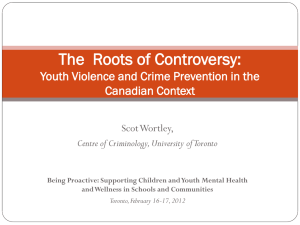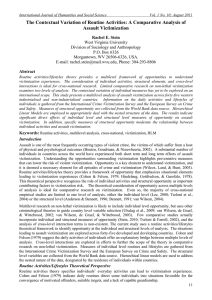Consequences of school bullying and violence
advertisement

Consequences of school bullying and violence Christina Salmivalli University of Turku, Finland • It is evident that children exposed to systematic victimization by their peers suffer from adjustment problems – Victimization is concurrently associated with depression, anxiety, low global and social self-concept, suicidal ideation, school avoidance (Card, 2003; Hawker & Boulton, 2000)… – Strongest effect sizes for internalizing problems, BUT victimization is also associated with externalizing problems – Victimization is even related to health problems (Rigby, 2001) – Several interpersonal correlates such as rejection, low number of friends and low friendship quality • The bullies, and especially bully-victims, suffer from adjustment problems as well • Are the associations between victimization and maladjustment only concurrent, or does victimization longitudinally predict adjustment problems? • OVERALL: • Studies investigating the consequences of victimization while controlling for intitial levels in the variables of interest are still surprisingly rare • Many of the concurrent correlates of victimization seem to be both antecedents and consequences of it – A vicious cycle by which children get trapped in the role of continued victimization • HOWEVER: – Internalizing problems, such as depression, seem to increase as a result of victimization rather than precede it – Low self-esteem, on the other hand, is clearly an antecedent of victimization, whereas evidence of longitudinal changes in (global) self-esteem resulting from victimization is more mixed (e.g., Card, 2003) Prospective relations between victimization, rejection, friendlessness and children’s selfand peer-perceptions Christina Salmivalli University of Turku, Finland (unpublished data) Grade 5/6 Grade 6/7 .41 self(1) -.14 -.21 -.17 peer(1) self(3) chronic vic (1-2) chronic rej (1-2) chronic fri (1-2) .44 .29 .63 vic(3) rej(3) -.25 .23 .14 -.13 fri3 peer(3) .31 Figure 2. The final model (chi-square (23)=30.16, p=.14; CFI=.99; RMSEA=.04). • In the short term, victimization seems to influence children’s generalized perception of peers, rather than their view of themselves • A negative self-perception is clearly a risk factor for victimization (but also for other peer relationship adversities, such as rejection and friendlessness) What about the long run? • Follow-up studies examining the long-term consequences of victimization are, to date, almost nonexistent – As an exception, Olweus (1994) followed up 87 men who had been assessed in grade 9 (and, most of them, also in grade 6) up to 23 years of age. – The former victims were relatively well-adjusted in many respects. However, they had a lower self-esteem and they suffered from depression more often than their non-victimized age-mates. Long-term influences of victimization: a follow-up from adolescence to young adulthood Christina Salmivalli University of Turku, Finland (unpublished data) Participants of the study • 274 young adults (145 male and 129 female), who had been involved in a research on school bullying in grade 8 (1996), were approached by mailed questionnaires eight years later (2004) – measures of: depression, self-perception, perception of other people, and interpersonal goals • 52.4% of men and 78.3% of women responded – overall response rate = 64.6% 1996 opp-sex noms same-sex noms vic 2004 self-rep depression self others Victimization in grade 8 (1996) assessed with - two self-report items: my classmates make fun of me; people pick on me -peer-nominations from same-sex and opposite-sex classmates Depression: BDI, α = .91 Self-perception: Rosenberg SE items, with the instruction to report ”the way you feel about yourself when interacting with people of your own age”, α = .86 Perception of other people: 13 items describing positive and negative qualities of other people (age-mates), such as "they can really be relied on", "they are hostile", or "they really care about what happens to me" α=.88 1996 opp-sex noms same-sex noms vic 2004 self-rep .15 -.17 -.22 depression self others 1996 opp-sex noms same-sex noms 2004 self-rep -.14 vic .16 .18 .35 ”happiness and satisfaction” ”Happiness and satisfaction” scale: I am a happy person; I like being the way I am; I wish I were different; I am unhappy; I am cheerful; I am a lucky person, α=.72 depression self others 1996 opp-sex noms same-sex noms vic 2004 self-rep .13 depression .33 self -.20 others .16 .15 ”happiness and satisfaction” 1996 opp-sex noms same-sex noms vic 2004 self-rep .16 depression .32 self -.16 others .16 .44 ”happiness and satisfaction” perceived popularity .60 χ2(5)=9.09, p=.11, CFI=.97, RMSEA=.07 Perceived popularity: 11 items (e.g., I am not very popular; I have many friends). .16 perceived family support Perceived family support: 6 items (e.g., Nobody cares for me at home; my parents like me) • Victimization in adolescence (grade 8, age 14-15) was predictive of young adults’ (age 22-23) depression and their perception of other people • These influences were significant even controlling for scores on ”happiness and satisfaction” measure in grade 8 • Unlike victimization, perceived popularity and/or perceived family support did not predict variance in any of the outcome variables eight years later Consequences for the group? • Bukowski and Sippola (2001): "victimization not only damages the individual, but damages the group itself as well as the individuals who constitute the group” • How does victimization damage the group? Experienced and observed victimization and school satisfaction • With multilevel modeling, it is possible to disentangle the variance in school satisfaction between individual students, from variance between different school classes operationalization of school satisfaction: MARK THE FACE THAT BEST DESCRIBES YOU WHEN AT SCHOOL . . ____ . . ____ . . _____ x . . _____ . . _____ . . _____ . . _____ A study with 48 classrooms (grades 4 to 6) - some initial findings: • Classrooms differ from each other in the overall degree of victimization – differences in experienced victimization are between individual children, rather than between classrooms: significant differences in observed victimization can be detected between classrooms, however – there are also significant differences between classrooms in school satisfaction • At the individual level, experienced victimization is related to lowered level of school satisfaction • At the classroom level, the overall degree of victimization in the classroom is related to lowered level of school satisfaction experienced victimization observed victimization 1.00 .72 BETWEEN-LEVEL: (explaining variation between classrooms) degree of victimization in the classroom -.31 shool enjoyment / satisfaction WITHIN-LEVEL: (explaining variation between students) .16 observed victimization experienced victimization 1.00 gender -.06 (n.s.) -.14 experienced victimization .61 1.00 observed victimization Research on consequences of victimization: some future challenges • More prospective studies controlling for adjustment variables at time 1 are needed, to avoid confounding antecedents of victimization from their consequences • Need to identify mechanisms of influence • Need to identify moderators – protective factors ? • Group-level consequences (as well as antecedents) of victimization/aggression are not yet well-known • And what about group-level protective factors?








